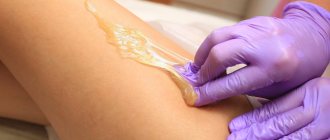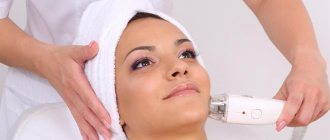You can remove excess hair using an electric epilator for home use - a compact, ergonomic device that removes hair from the root. With the right choice, the effect of use will be no worse than in the salon. That’s why it’s so important to approach the issue of purchasing an electric epilator responsibly.
Types of electric epilators and their features
There are several types of electric epilators - the features of the products need to be known in advance in order to choose the appropriate option.
Needle-shaped
Needle electroepilators are considered effective. When using the devices, a thin needle is inserted into the follicle to a depth of 0.5 mm, applying current. Such devices are used in specialized salons due to their high cost.
Divided into the following types:
- Thermolysis. Represents an alternating effect of current. It is the most effective procedure, completely removing the hair follicle. The thermolysis procedure is painful, and it is not possible to remove the follicle the first time.
- Electrolysis. A painless technique based on applying current through the surface of the epithelium. During electrolysis, the needle is not inserted under the skin, so its integrity is not compromised. The applied current produces sodium ions, which, when combined with tissue fluid, form an alkali that “kills” the follicles.
- The “blend” method combines the procedures listed above. Hair follicles are heated by electric current and then destroyed by alkaline acid.
Needles for needle electroepilators are made of medical steel, coated with Teflon (suitable for those who do not tolerate pain well), gold-plated needles are suitable for allergy sufferers.
Tweezers
The technique of electroepilators with tweezers is as follows: each hair is captured with tweezers, through which a current is passed every 2-3 minutes. The procedures performed using the equipment are safe and do not cause pain.
As beauty industry experts note, using a tweezer epilator can hardly be called effective. And all because the current does not reach the follicle - the hairs do not conduct it, which is why the follicle is not destroyed 100%. To solve this problem, a special gel was invented that improves the passage of current.
Types of electrolysis
It doesn’t matter whether the electrolysis device is used at home or in a salon, all methods are divided into two main types: hair removal using tweezers or a needle. Further there are only variations of these tweezers or needles.
Tweezers
To supply current to the follicle using this method, the hair is grabbed with tweezers-electrode, through which the charge passes. But in order for the hair root to really collapse, the charging time should be 1.5-2 minutes. Therefore, tweezer electrolysis is not very suitable for treating large areas of the body and, in principle, is not very popular. But it is the most painless.
Electrolysis with thread or needle
Most often, they resort to the needle method, when the follicle is destroyed by applying current directly to the follicle through a needle inserted into it. Its thickness usually does not exceed 0.1 mm, and it can be made from different materials, which determine the specifics of its use.
A gold needle for electrolysis is used to perform the procedure on those clients whose skin is prone to allergic reactions.
There are tools with Teflon insulation , the coating thickness of which is one micron. They are used for clients who have a low pain threshold.
Such needles minimally affect surrounding tissue and therefore do not cause burns.
The rest, who tolerate the procedure normally and are not prone to irritation or burns, undergo electrolysis with acupuncture needles made of medical alloy.
Needles of varying thicknesses are also used. The size depends on the thickness of the hair: the thicker it is, the more intense the charge flow should be supplied, the thicker the needle should be.
In addition to these parameters, tools come in different shapes: curved or straight. The choice of form depends on the skills of the master and his habits. Some people find it more convenient to work with curved instruments, while others find it more convenient to work with straight ones, like a ballet needle for electrolysis.
, tungsten filament can be used .
To carry out the procedure, it is necessary to cut it at an angle, insert the sharp tip into the follicle, and only then apply current through it. The procedure with a thread will not be less painful, it may have the same side effects, but it requires more experienced hands of a master. He must be able to cut, sharpen and insert thread correctly. But in general, there is not much difference between electrolysis with a tungsten thread and any needle.
How to choose a device for your home?
The best option is to use tweezer electroepilators, which do not destroy the follicle, but injure it. This makes the procedure itself safe and painless. You can also use a needle type of electric epilator, but only if you have experience working with such equipment, since the woman’s safety and health depends on it.
But there are a number of parameters that are worth paying attention to:
- Speed. Most epilators operate at 2 speeds. The first is used when working with thin hairs, the second is more suitable for coarse and thick ones. At first, experts, while there is no experience, advise working with the device at first speed.
- Brand. It is better to choose products from trusted brands - in this case, the quality of the device and a long period of use are guaranteed.
- Design. The main thing when buying an epilator is the technical characteristics of the device. However, the comfort of use depends on the shape of the device. Therefore, before purchasing equipment, it is recommended to hold the device in your hands for a while and evaluate its convenience.
- Price. You should not buy a cheap device. Most often, such electric epilators do not differ in quality and reliability, and will not last long.
The papilla is a moving target
Let's assume that the papilla alone is responsible for hair growth and is the sole target for the electrologist.
This would lead to the conclusion that only destruction of the hair papilla will be effective. Many electrologists assume that the papilla is stationary and can be easily detected by the tip of a needle. They will ask you to insert the needle to the full anagen depth in order to locate and cauterize just the papilla. However, this approach is erroneous.
Due to misunderstanding of medical drawings, many electrologists and article authors assume that the papilla is always fixed at full anagen depth. Several electrolysis textbooks have even drawn diagrams of hair growth that incorrectly show that the papilla remains at full anagen depth while the follicle and hair enter the telogen phase.
However, the hair papilla is a moving target! The papilla moves upward with the contracting telogen follicle and can actually rise up to 2/3 of the follicle's full depth. This phenomenon is called “hair papilla drift.”
Remember that the blend method causes destruction along the entire length of the follicle. Therefore, no matter where the hair papilla moves and no matter what stage of growth the follicle is in (anagen, catagen or telogen), the Blend will destroy the papilla. This aspect is probably the main reason for the greater effectiveness of the blend method.
In the picture on the left is the effect of automatic thermolysis (the target is only the hair papilla), on the right is a blend to the full depth of anagen. Both methods destroy the papilla.
The picture on the left shows the effect of automatic thermolysis. On the right is a blend to the full depth of telogen. Automatic thermolysis did not destroy the papilla, while the blend coped with the task
Review of manufacturers and models
There are many electric epilators on the market for cosmetology services, which differ both in purpose and in the way they work.
Among domestic products there are:
- “Bumblebee 1000” from the Moscow plant “Proton”. This device is inexpensive, easy to use, and reliable. It removes hair using flash hair removal, but on sale you can find models with an electrocoagulator, however, they are recommended for use in salon conditions.
- Device “EHVCh-20-MTUSI”. In many Moscow salons you can find the “MTUSI electrolysis” service, that is, using a coagulator developed at the Moscow Technical University. The epilator has thermolysis, and the ability to adjust time and current power is also available.
- Epilator “KOEP-1”. A domestic device with various functions: you can perform electrolysis and coagulation, it has a hair removal counter function, and a timer.
Top foreign manufacturers and models:
- Rowenta EP7530. A reliable electric epilator that causes virtually no pain due to the supply of cold air. There is also Soft Sensation technology, which slightly smoothes the skin, which eliminates the pain when removing hair. The Rowenta EP7530 model has 2 speeds and internal lighting. However, not every girl succeeds in removing hair the first time.
- Braun 5329 Silk-epil 5. This electroepilator comes with a special attachment for cleaning the face. This equipment is characterized by high power, which ensures smooth skin, while this Braun model also copes with fine hairs. And thanks to the presence of a special cooling glove, you can soothe your skin. The disadvantages of the model include a high noise level and an insufficiently long wire.
- Philips HP6548. An epilator that removes even the finest hairs due to the presence of ceramic textured discs and a vibration effect. The model is equipped with 2 speeds, the head can be washed with water. The kit includes a cleaning brush and a case.
Operating principle of the devices
The operation of electric epilators is based on the use of electric current. The devices deliver shocks into the hair follicles through thin needles or tweezers. Due to the impact, the follicles are destroyed forever. This method is effective for any zones.
It is possible to treat a small area in one session. Each hair is processed separately. For 100% effect, a full course of procedures is required. It lasts 1-1.5 years.
Thermolysis
Alternately passes high-frequency current discharges into the hair. The technology promotes the complete destruction of follicles. Among its disadvantages, patients note that it is painful to use. It is not always possible to get rid of hair the first time.
Electrolysis
Direct current affects the hair, entering through the skin. The needle penetrates the epidermis, so epilation does not cause pain. The session lasts for a long time. It takes 0.5-1 minutes to process each hair.
Bland
The current supply has a reduced amplitude. The method is recognized as optimal for combating ingrown hairs. The thermal effect that occurs during the process activates the rapid formation of alkali. This feature speeds up the destruction process. The exposure time on hair is reduced to 10 seconds.
Don't miss the most popular article in the section: Laser hair removal on the face and body - how it is done, effectiveness, before and after photos, contraindications.
Flash
Subtype of thermolysis. It produces electric shock in short bursts, but at a higher frequency. Needle electroepilators of this type have positive reviews. According to them, the procedure causes less discomfort and is highly effective.
Sequential blend
This is an improved version of the blend . During hair removal, the amplitude of the current to destroy the bulb slowly decreases. The patient feels almost no pain.
Sequential flash
This is a modified version of flash . Its distinctive feature is its accelerated action and periodic change in the period of follicle treatment. The method allows taking into account the patient's characteristics. It makes it possible to choose the operating mode in accordance with the thickness and structure of the hair shaft.
How to use it correctly at home?
The electrolysis procedure at home will be of high quality if you strictly follow all the important rules and properly prepare for the procedure.
General rules
After purchasing the device, you need to purchase an anesthetic drug. Most often they use Lidocaine or Emla ointment. Whatever product is used, it is used to treat the skin an hour before the procedure.
And to avoid an allergic reaction to the product, you must first test it on a small area. Before the procedure, be sure to treat the needles with alcohol to avoid infection.
After this, epilation is carried out. Upon completion, the skin will be reddish and swollen - you should not be afraid of this, this is how the body reacts to the procedure. The redness will go away in a couple of days. The event can be repeated after 20-25 days, but no later than after 2 months. If you regularly perform hair removal, then after an average of 10 sessions you can forget about the vegetation in the treated area for several years.
After electrolysis, slight redness of the skin may appear - this is a completely normal reaction.
Remember about contraindications that do not depend on the electrolysis method. It is not recommended to carry out the procedure on inflamed areas of the skin, especially if it is viral in nature. Hair removal is also contraindicated for those who:
- suffered a stroke;
- has diseases of the cardiovascular and endocrine systems;
- suffers from varicose veins.
Preparation for the process
The hair removal procedure does not require long preparation. It is important to keep your skin clean. Therefore, if possible, it is worth taking a bath and using a scrub that will remove the dead skin layer, which will simplify hair removal.
Remember that the length of the hairs should be at least 3 mm, but the most acceptable option is about 5-6 mm.
If you are afraid of pain, you can give local anesthesia using lidocaine cream or spray. In special salons, injections of Lidocaine or Ultracaine are used for this.
How to proceed during the procedure?
Using an electric epilator may have a number of nuances, which are described in more detail in the instructions. However, the general guidance is as follows:
- Connect the device to the network and install the needle in the holder. Treat your skin with an antiseptic in advance. Insert the needle into the pore to a depth of about 0.5 mm. Moreover, this should be done only in the direction of hair growth, which will allow you to get as close as possible to the follicle.
- Press the current supply plate and release after the time specified in the instructions.
- Remove the hair with tweezers - if it comes out easily, it means the procedure was carried out correctly. Repeat the procedure with other hairs, retreating 5 mm.
Follow-up skin care
The skin recovers after hair removal within a week. To prevent the process from being delayed, you need to follow simple care rules:
- the treated areas of skin should not come into contact with water in the next 24 hours;
- in the first 3 days you should avoid taking a bath, using perfume or cream;
- within 4-5 days after hair removal, you need to treat the skin with an antiseptic, which will avoid infection;
- Do not sunbathe for a week after the procedure, otherwise pigment spots may appear;
- You should refrain from any physical activity - this will cause sweating, which will make the recovery process longer;
- the crusts that appear cannot be peeled off - scars often form in their place;
- Do not touch the skin with dirty hands - this increases the risk of infection;
- You should take care that underwear and clothes do not rub areas of the skin after hair removal; it is better to choose loose items.
Electrolysis methods
The choice of device for carrying out the procedure largely depends on the method that the master prefers to use or which clients most often resort to. When choosing a device for home use, it is also worth first understanding the methods of electrolysis.
Thermolysis
This is one of the oldest methods of removing body hair using current. Thermolysis involves electrolysis using high frequency alternating current (9-14 MHz), which is applied through a needle inserted into the skin for 1-2 seconds. This takes quite a long time, so this procedure often leads to burns and scars.
The procedure is very painful, so it is not enough to use surface anesthetics, especially if the person has a low pain threshold. In such cases, an anesthetic is administered using traditional methods.
Did you know?
According to some studies, the liquid administered for pain relief changes the nature of the effect of the current and can reduce or neutralize the effect of electrolysis using the thermolysis method, and can generally lead to more intense hair growth.
Another important drawback of the procedure is the duration of current exposure per pulse. This leads to local overheating of the tissues, which causes burns.
Galvanic electrolysis
This is a more popular method compared to the previous one. Its essence lies in the fact that during the flow of current, a complex physico-chemical reaction takes place in the treated area: the formation of alkali and acid, which destroy the hair follicle.
To carry out galvanic electrolysis, two electrodes are used.
The neutral one is given to the client, and the active one is injected into the follicle in the form of a needle. But since it will take about a minute to destroy it, several tools are used at once to increase the area processed at a time. When the follicle collapses, a white foam appears on the surface of the skin. Then all that remains is to remove the removed hair with tweezers. Information? This is also a painful procedure, but it has much less risk of unpleasant consequences than thermolysis. True, it is quite long - one hair is processed for several seconds.
Blend method
Electrolysis using the blend method is a bit similar in principle to the galvanic method, but coagulation occurs as with thermolysis. Actually, that’s why the method is called “blend”, which means “mixed” in English. In this case, the alkali works more actively, so processing one hair takes an average of 10 seconds. It is used mainly for follicles that are deep-set, have uneven bulbs and from which thick hair grows.
The essence of the method is a step-by-step effect on the follicle. First, a thermolytic reaction occurs around it, and the surrounding tissues become dehydrated. Then a galvanic reaction occurs with direct destruction of the follicle. With this method, much less alkali is needed, and therefore the process occurs much faster.
With its help, electrolysis can be effectively performed at home. Modern devices have a computer unit on which you can select the appropriate ratio of all phases depending on your needs. But the method still has a high risk of burns.
Sequential blend
"Sequence" translated from English means "sequential". This is an improved procedure of the method described above. The improvements lie in the fact that with a sequence blend, the amplitude of the current decreases during the application of an electrical pulse. This not only reduces pain, but also has a more destructive effect on the follicle.
Flash method
This procedure is considered a subtype of thermolysis. Its essence is not difficult to understand from the name: “flash” in English means “flash”. This is thermolysis, in which the current strength is increased, its frequency reaches 2000 kHz, but its exposure time is reduced to 0.1-0.01 seconds. Despite the fact that the needles used must be insulated, electrolysis using the flash method has a greater risk of burns if the intensity of the current is not well calculated.
Sequential flash
Based on the example of previous descriptions, it is easy to guess that the method is an improved procedure of the flash method. The device allows you to set the frequency of sinusoidal alternating current. This is a big plus, since even within one area there can be hair of different quality. Sequential flash also allows you to quickly change the pulse duration, which is also an undeniable advantage, since hair of different thicknesses can grow even nearby.
Reviews
Elena, 28 years old, Omsk : “I spent a long time choosing which epilator to buy, and decided to buy Rowenta. I liked the value for money. True, the first time I did hair removal for about 3 hours - it was painful. But after a couple of sessions there was no such sensation anymore, I got used to it. The only negative is that the hairs grew unevenly at first, but this problem was solved over time.”
Alexandra, 30 years old, Vladivostok : “In recent years I have been using a razor, but it’s been 6 months since I switched to an epilator. At first I did it in a salon, now I do it on my own. At the very beginning it was unpleasant, it felt like an electric shock. But after a couple of sessions I got used to it, but now I don’t think about the smoothness of my legs. I have a Braun epilator - it’s inexpensive and just right for the price for the first time. But next time I’ll buy a more powerful device.”
Possible consequences
Due to skin irritation during the procedure, some unpleasant symptoms may be observed after the procedure, which go away on their own after some time. Possible occurrence:
- pain felt for some period of time after hair removal;
- swelling, redness, swelling that persists for several days;
- skin rashes in the form of pimples, papules, pustules, blackheads;
- crusts or peeling that should never be combed;
- temporary pigmentation in the area of skin treatment;
- noticeable injection sites that do not disappear for a long time.
Many of these consequences cannot be avoided, but they can be minimized by following these recommendations:
- After the procedure, wear only loose clothing to prevent it from affecting the newly epilated areas.
- For 2-3 days after hair removal, you cannot use cosmetics, with the exception of antiseptics and healing ointments or creams.
- You should avoid contact with water on the treated skin areas for about a day.
- Do not remove crusts or flaking particles under any circumstances.
- You cannot sunbathe or visit a solarium.
- Avoid excessive physical activity, visiting baths and saunas, which cause increased sweating, which can cause itchy skin.
Reference! The recovery period after electrolysis is usually about 1.5-2 weeks. During this period of time, it is recommended to adhere to the above recommendations.
Buying a home epilator
It is not always clear where you can purchase a needle electroepilator, which is medical equipment. Everything is much simpler - there are many online stores where this device can be ordered. You can buy an epilator in offline stores, as well as their online versions. It makes sense to explore the offers of not only Russian, but also foreign sellers (AliExpress, Ebay). You can find a specialized medical equipment store and order an electric epilator there.
Since needle devices for hair removal are expensive and remove them forever, there are cases of purchasing a used epilator from a person who no longer needs it. In this case, the price of the device will decrease by several thousand rubles. For example, the well-known needle electroepilator “Bumblebee” will cost about 20-25 thousand rubles after first-hand use.
Author: Roman Kozhukhov











